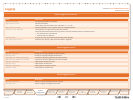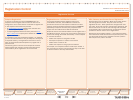
D 14049.01
07.2007
33
TANDBERG VIDEO COMMUNICATION SERVER
ADMINISTRATOR GUIDE
Text goes here
Introduction
Getting
Started
System
Overview
System
Configuration
H.323 & SIP
Configuration
Registration
Control
Zones and
Neighbors
Call
Processing
Firewall
Traversal
Bandwidth
Control
Maintenance
Appendices
TANDBERG VIDEO COMMUNICATION SERVER
ADMINISTRATOR GUIDE
H.323 & SIP
Configuration
About H.323 on the VCS
The VCS supports the H.323 protocol: it is an H.323
gatekeeper, and will provide interworking between H.323 and
SIP calls. In order to support H.323, the H.323 mode must be
enabled.
Call Time to Live
Once the endpoint is in a call, the VCS will periodically poll it
to confirm whether it is still in the call. The VCS allows you to
configure the interval at which the endpoints are polled, known
as the Call Time to Live.
Configuring H.323 Ports
The VCS enables you to configure the listening port for H.323
registrations and call signaling, and the range of ports to be
used by H.323 calls once they are established.
The default VCS configuration uses standard port numbers so
you can use H.323 services out of the box without having to
first set these up.
Using the VCS as an H.323 Gatekeeper
As an H.323 gatekeeper, the VCS accepts registrations from
H.323 endpoints and provides call control functions such as
address translation and admission control.
Working with H.323
H.323 Overview
Time to Live
H.323 endpoints must periodically re-register with the VCS in
order to confirm that they are still functioning. The VCS allows
you to configure the interval between these re-registrations,
known as the Time to Live.
Some older endpoints do not support the ability to
periodically re-register with the system. In this case,
and in any other situation where the system has not had
a confirmation from the endpoint within the specified period, it
will send an IRQ to the endpoint to verify that it is still
functioning.
The system will poll endpoints in a call regardless of
whether the call type is traversal or non-traversal.
H.323 Endpoint Registration
Auto Discover
The VCS has an Auto discover setting which determines
whether it will respond to the Gatekeeper Discovery Requests
sent out by endpoints.
To prevent H.323 endpoints being able to register automatically
with the VCS, set Auto Discover to Off. This will mean that
endpoints will be able to register with the VCS only if they have
been configured with the VCS’s IP address.
Overview
H.323 endpoints in your network must register with the VCS in
order to use it as their gatekeeper.
There are two ways an H.323 endpoint can locate a VCS
with which to register: manually or automatically. The option
is configured on the endpoint itself under the Gatekeeper
Discovery setting (consult your endpoint manual for how to
access this setting).
If the mode is set to automatic, the endpoint will try to
register with any VCS it can find. It does this by sending out
a Gatekeeper Discovery Request, to which eligible VCSs will
respond.
If the mode is set to manual, the you must specify the IP
address of the VCS with which you wish your endpoint to
register, and the endpoint will attempt to register with that
VCS only.
•
•
Registration Conflict Mode
An H.323 endpoint may attempt to register with the VCS using
an alias that has already been registered on the VCS from
another IP address. The reasons for this could include:
two endpoints at different IP addresses are attempting to
register using the same alias
a single endpoint has previously registered using a particular
alias. The IP address allocated to the endpoint then
changes, and the endpoint is attempting to re-register using
the same alias.
You can determine how the VCS will behave in this situation by
configuring the Registration Conflict Mode. The options are:
Reject: denies the registration.
Overwrite: deletes the original registration and replaces it
with the new registration.
•
•
•
•


















